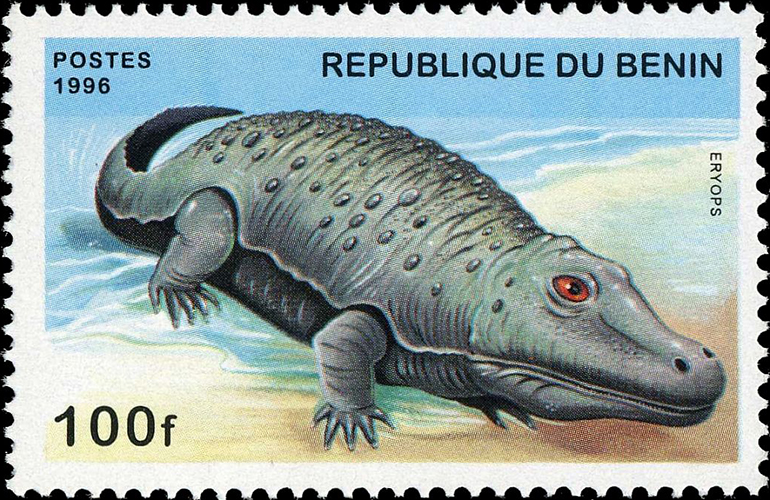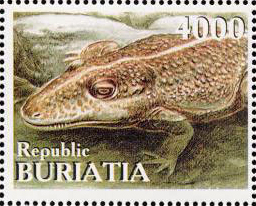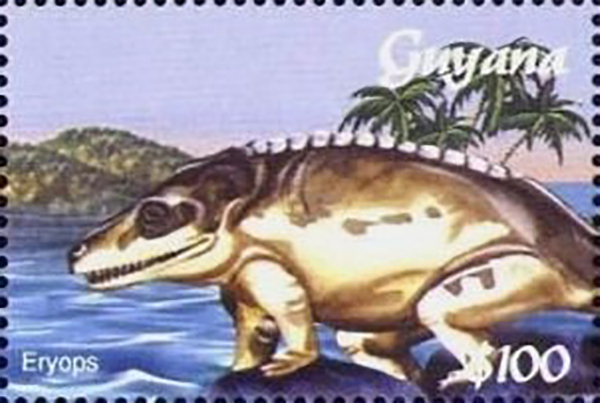Eryops megacephalus Cope, 1877

Phylum: Chordata Haeckel, 1874
Subphylum: Vertebrata Cuvier, 1812
Classe: Amphibia Gray 1825
Ordine: Temnospondyli Zittel, 1888
Famiglia: Eryopidae Cope, 1882
Genere: Eryops Cope, 1877
Descrizione
L'eriops si aggirava tra le paludi e i laghi del Nordamerica. Forse, come le rane e molti anfibi attuali, passava la maggior parte del suo tempo sulla terraferma. Le zampe erano corte ma robuste, adatte a reggere il corpo massiccio, lungo anche due metri: la coda era abbastanza corta; la testa, larga e piatta, era dotata di una dentatura formidabile che contraddistingue l'eriope come un feroce predatore. Questo anfibio si spostava grazie alle potenti zampe che sporgevano lateralmente piegandosi ad angolo retto. Si nutriva di pesce e di piccoli anfibi, aggirandosi lungo le rive di corsi d'acqua in attesa di catturarli.
Diffusione
Era un grande anfibio preistorico, vissuto nel Permiano inferiore (circa 280 milioni di anni fa) in Nordamerica. I suoi resti sono stati rinvenuti in Texas, Oklahoma e Nuovo Messico.
Bibliografia
–Schoch, Rainer R. (2009). "Evolution of life cycles in early amphibians". Annual Review of Earth and Planetary Sciences. 37 (1): 135-162.
–Rinehart, L. F.; Lucas, S. G. (2013). "Tooth form and function in temnospondyl amphibians: relationship of shape to applied stress" (PDF). New Mexico Museum of Natural History Bulletin. 61: 533-542.
–Pawley, Kat; Warren, Anne (2006). "The appendicular skeleton of Eryops megacephalus Cope, 1877 (Temnospondyli: Eryopoidea) from the Lower Permian of North America". Journal of Paleontology. 80 (3): 561-580.
–Romer, A. S.; Witter, R. V. (1941). "The skin of the rachitomous amphibian Eryops". American Journal of Science. 239 (11): 822-824.
–Gould, Stephen Jay, ed. The Book Of Life: An Illustrated History of the Evolution of Life on Earth. W.W. Norton: 2001, pg. 94. Retrieved August 28, 2017.
–Werneburg, Ralf; Berman, David S (2012). "Revision of the aquatic eryopid temnospondyl Glaukerpeton avinoffi Romer, 1952, from the Upper Pennsylvanian of North America". Annals of Carnegie Museum. 81: 33-60.
–Murphy, James L. (1971). "Eryopsid Remains from the Conemaugh Group, Braxton County, West Virginia". Southeastern Geology. 13 (4): 265-273.
–Werneburg, R.; S.G. Lucas; J.W. Schneider; L.F. Rinehart (2010). "First Pennsylvanian Eryops (Temnospondyli) and its Permian record from New Mexico". In Lucas, S.G.; J.W. Schneider; J.A. Spielmann (eds.). Carboniferous-Permian transition in Canõn del Cobre, northern New Mexico. New Mexico Museum of Natural History and Science Bulletin. 49. pp. 129-135.
–Quémeneur, S.; de Buffrénil, V.; Laurin, M. (2013). "Microanatomy of the amniote femur and inference of lifestyle in limbed vertebrates". Biological Journal of the Linnean Society. 109 (3): 644-655.
–Van Valkenburgh, B.; Jenkins, I. (2002). "Evolutionary patterns in the history of Permo-Triassic and Cenozoic synapsid predators". Paleontological Society Papers. 8: 267-288.

|
Data: 30/08/1996
Emissione: Animali preistorici Stato: Benin |
|---|

|
Data: 01/01/1999
Emissione: Animali preistorici marini Stato: Buryatia |
|---|

|
Data: 28/03/2001
Emissione: Creature preistoriche Stato: Guyana Nota: Emesso in un foglietto di 6 v. diversi |
|---|